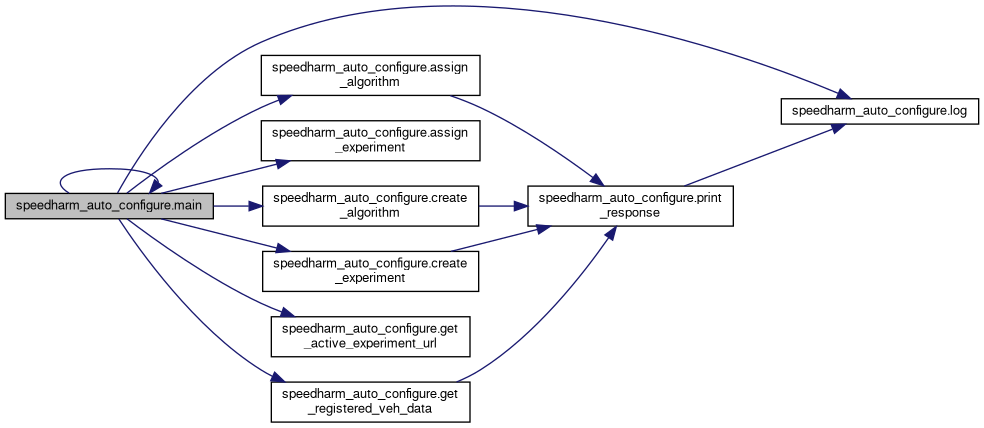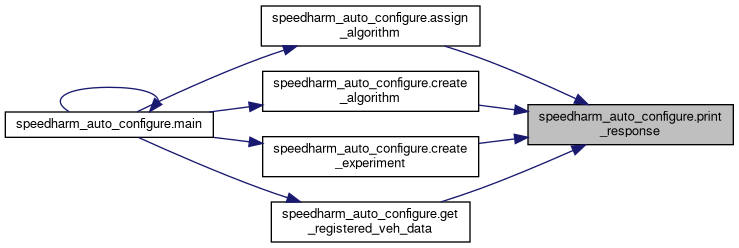Functions | |
| def | log (msg) |
| def | print_response (resp) |
| def | get_active_experiment_url () |
| def | create_experiment (desc, loc) |
| def | assign_experiment (veh_id, experiment_url) |
| def | get_registered_veh_data () |
| def | create_algorithm (algo_name) |
| def | assign_algorithm (veh_id, algo_url) |
| def | main () |
Variables | |
| string | version_id = "v0.1" |
| string | base_url = "http://35.153.64.44:8081" |
| string | vehicles_url = "/rest/vehicles" |
| string | experiments_url = "/rest/experiments" |
| string | algorithms_url = "/rest/algorithms" |
| string | default_algorithm = "gov.dot.fhwa.saxton.speedharm.executive.algorithms.ReduceSpeedAlgorithm" |
| int | sleep_duration_millis = 1000 |
Function Documentation
◆ assign_algorithm()
| def speedharm_auto_configure.assign_algorithm | ( | veh_id, | |
| algo_url | |||
| ) |
Definition at line 85 of file speedharm_auto_configure.py.
References create_two_lane_map.int, and print_response().
Referenced by main().


◆ assign_experiment()
| def speedharm_auto_configure.assign_experiment | ( | veh_id, | |
| experiment_url | |||
| ) |
Definition at line 66 of file speedharm_auto_configure.py.
References create_two_lane_map.int.
Referenced by main().

◆ create_algorithm()
| def speedharm_auto_configure.create_algorithm | ( | algo_name | ) |
Definition at line 76 of file speedharm_auto_configure.py.
References print_response().
Referenced by main().


◆ create_experiment()
| def speedharm_auto_configure.create_experiment | ( | desc, | |
| loc | |||
| ) |
Definition at line 59 of file speedharm_auto_configure.py.
References print_response().
Referenced by main().


◆ get_active_experiment_url()
| def speedharm_auto_configure.get_active_experiment_url | ( | ) |
Definition at line 51 of file speedharm_auto_configure.py.
Referenced by main().

◆ get_registered_veh_data()
| def speedharm_auto_configure.get_registered_veh_data | ( | ) |
Definition at line 71 of file speedharm_auto_configure.py.
References print_response().
Referenced by main().


◆ log()
| def speedharm_auto_configure.log | ( | msg | ) |
Definition at line 41 of file speedharm_auto_configure.py.
References create_two_lane_map.str.
Referenced by main(), and print_response().

◆ main()
| def speedharm_auto_configure.main | ( | ) |
Definition at line 91 of file speedharm_auto_configure.py.
References assign_algorithm(), assign_experiment(), create_algorithm(), create_experiment(), get_active_experiment_url(), get_registered_veh_data(), log(), main(), and create_two_lane_map.str.
Referenced by main().


◆ print_response()
| def speedharm_auto_configure.print_response | ( | resp | ) |
Definition at line 46 of file speedharm_auto_configure.py.
References log().
Referenced by assign_algorithm(), create_algorithm(), create_experiment(), and get_registered_veh_data().


Variable Documentation
◆ algorithms_url
| string speedharm_auto_configure.algorithms_url = "/rest/algorithms" |
Definition at line 37 of file speedharm_auto_configure.py.
◆ base_url
| string speedharm_auto_configure.base_url = "http://35.153.64.44:8081" |
Definition at line 32 of file speedharm_auto_configure.py.
◆ default_algorithm
| string speedharm_auto_configure.default_algorithm = "gov.dot.fhwa.saxton.speedharm.executive.algorithms.ReduceSpeedAlgorithm" |
Definition at line 38 of file speedharm_auto_configure.py.
◆ experiments_url
| string speedharm_auto_configure.experiments_url = "/rest/experiments" |
Definition at line 36 of file speedharm_auto_configure.py.
◆ sleep_duration_millis
| int speedharm_auto_configure.sleep_duration_millis = 1000 |
Definition at line 39 of file speedharm_auto_configure.py.
◆ vehicles_url
| string speedharm_auto_configure.vehicles_url = "/rest/vehicles" |
Definition at line 35 of file speedharm_auto_configure.py.
◆ version_id
| string speedharm_auto_configure.version_id = "v0.1" |
Definition at line 31 of file speedharm_auto_configure.py.